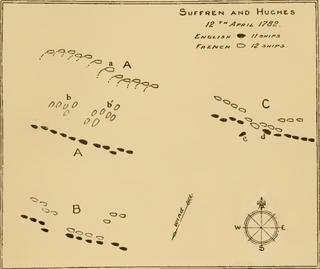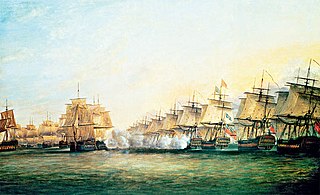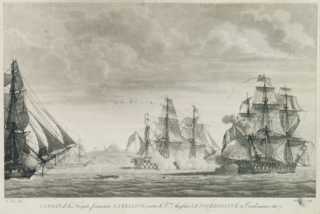Background
France had entered the American Revolutionary War in 1778, and Britain declared war on the Dutch Republic in late 1780, after the Dutch refused to stop trading in military supplies with the French and the Americans. The British had rapidly gained control over most French and Dutch outposts in India when news of these events reached India, spawning the Second Anglo-Mysore War in the process. Negapatam was besieged and taken by Sir Hector Munro in November 1781.
The French admiral the Bailli de Suffren was dispatched on a mission to provide military assistance to French colonies in India. He arrived in February 1782 and immediately engaged the British fleet of Vice-Admiral Sir Edward Hughes in the inconclusive Battle of Sadras. After both fleets spent time in port repairing, refitting, and re-provisioning, they met again in the April Battle of Providien, south of the Ceylonese port of Trincomalee, that was ended by a storm and then nightfall. Hughes put into Trincomalee, a formerly Dutch port the British had captured in January, for repairs, while Suffren went to the Dutch-controlled port of Batticaloa.
While at Batticaloa, Suffren received dispatches from Île de France (now Mauritius) that ordered him to return there to escort additional French troops to India. He chose not to do so, citing the parity between the two fleets, and the need to defend French troops already on the ground in India against the movements of the British fleet.
The French, with about 2,000 effective troops under the command of Comte du Chemin, had captured Cuddalore on 6 May. Hyder Ali, the ruler of Mysore, originally wanted the French to take the more important port of Negapatam. The French joined with Hyder's army of 60,000 to lay siege to the British at Vandavasi. When the British sent an army of 12,000 toward Vandavasi to relieve the siege, du Chemin, against the wishes of Hyder, refused to engage in a battle that the Franco-Mysorean force would probably have won (which would have significantly reduced the British military presence in India). As a result, Hyder lifted the siege and retreated to the vicinity of Pondicherry.
Hyder Ali learned of Suffren's actions in the first two battles with Hughes, and sent a message to Suffren to arrange a meeting. Suffren had in the meantime sailed from Batticaloa to do the job that du Chemin would not: capture Negapatam. He stopped at Cuddalore on 20 June to take on troops and supplies for the attack, which he hoped to do by surprise. When he was ready to sail, he learned that Hughes had sailed past, apparently also en route to Negapatam. As his fleet had grown by captured prizes and arrivals from Île de France (it was now twelve ships of the line and four frigates), Suffren gave chase and caught up with Hughes, who had anchored off Negapatam, on 5 July.
Battle
Suffren was in the process of forming his battle line around 3:00 pm when a squall took down the main and mizzen top masts of Ajax, under Bouvet-Précourt, forcing her to drop out of his line. When the squall calmed, the breeze was to Hughes's advantage, so he sailed from his anchorage at the harbour of Negapatam. The two fleets spent the night anchored two cannonshots apart.
The next morning, Suffren was infuriated to learn that repairs had not been made to Ajax, and that her captain wanted to retreat. Given that battle was imminent, Suffren refused. He then ordered his line to bear down on the British line for close action. As they began to move, Ajax stood away and did not join the action. At 9:30 am on 6 July, the fleets opened fire on each other, first at long range. Flamand engaged Hero and Exeter, Annibal engaged Isis, Sévère faced Burford, and Brillant opposed Sultan while the two flagships, Héros and Superb, did battle with each other. The remainder of the British line was not able to directly line up against the French, resulting in an angle in their line where Sphinx and Monarca battled that minimized the action between the ships at the end of the line. Flamand took significant damage, but was able to return the favour to its opponents. Brillant began to suffer under the fire of Sultan, but Suffren managed to detach from Héros to come to her rescue.
The battle proceeded with vigour until about 1:00 pm, when the wind suddenly changed, throwing both lines into confusion. With the wind head-on to the two parallel lines of ships, some ships turned to starboard and some to port. [8] The majority turned away from the engagement, but six ships, four British and two French, turned in towards one another. The four British ships were the fourth, fifth, eighth and tenth in line, respectively Burford, Sultan, Worcester and Eagle; the two French were Sévère (third in line) and towards the rear of the line Brillant, which had been dismasted by this stage. Sévère was engaged by Sultan and "two other ships," and escaped through the arrival of Suffren in his flagship and the filling of her sails as she fell off to starboard, while Brillant was fired on by Worcester and Eagle, and was also rescued by the approach of Suffren's ship, though not before the loss of over a third of her complement dead or wounded. [8]
With occasional meetings between two ships, Hughes attempted to reform his line around 2:00 pm, but neither fleet was in a state to adopt battle positions easily, so Suffren decided to draw away downwind, to the north, toward Cuddalore. One British observer noted that "our fleet was utterly incapable of preventing or pursuing them." [9]

The Battle of Sadras was the first of five largely indecisive naval battles fought between a British fleet and a French fleet off the east coast of India during the Anglo-French War. Fought on 17 February 1782 near present-day Kalpakkam, the battle was tactically indecisive, but the British fleet suffered the most damage. Under Suffren's protection, French troop transports were able to land at Porto Novo, present-day Parangipettai.

The Battle of Cuddalore was a naval battle between a British fleet, under Admiral Sir Edward Hughes with Admiral L.J. Weiland, and a smaller French fleet, under the Bailli de Suffren, off the coast of India during the American Revolutionary War. This war sparked the Second Mysore War in India. In the battle, taking place near Cuddalore on 20 June 1783, Suffren commanded the engagement from the frigate Cléopâtre and won what is generally considered a victory. Peace had already been agreed upon in Europe, but that news had yet to reach India, making this the final battle of the war.

The Battle of Providien was the second in a series of naval battles fought between a British fleet, under Vice-Admiral Sir Edward Hughes, and a French fleet, under the Bailli de Suffren, off the coast of India during the Anglo-French War. The battle was fought on 12 April 1782 off the east coast of Ceylon, near a rocky islet called Providien, south of Trincomalee.

The Battle of Trincomalee was fought between a British fleet under Vice-Admiral Sir Edward Hughes and a French fleet under the Bailli de Suffren off the coast of Trincomalee, then Ceylon, on 3 September 1782. It was the fourth in a series of battles fought between the two fleets off the coast of the Indian subcontinent during the American Revolutionary War.

Bellone was an Iphigénie-class 32-gun frigate of the French Navy on plans by Léon-Michel Guignace. She took part in the American Revolutionary War in the Indian Ocean with the squadron under Suffren, and later in the French Revolutionary Wars. She was present at the Glorious First of June.
The Illustre was a 74-gun Magnanime class ship of the line of the French Navy. She took part in the War of American Independence and in the French Revolutionary Wars. Damaged beyond repairs during the Expédition d'Irlande, she was scuttled on 30 December 1796.

Admiral comte Pierre André de Suffren de Saint Tropez, bailli de Suffren, Château de Saint-Cannat) was a French Navy officer and admiral. Beginning his career during the War of the Austrian Succession, he fought in the Seven Years' War, where he was taken prisoner at the Battle of Lagos. Promoted to captain in 1772, he was one of the aids of Admiral d'Estaing during the Naval battles of the American Revolutionary War, notably taking part in the Siege of Savannah.
The Pourvoyeuse was a 40-gun frigate of the French Navy, lead ship of her class. She is notable as one of the earliest attempts at building a frigate armed with 24-pounders on the artillery deck, rather than the 18-pounders typical of the day.

Brillant was a 64-gun Solitaire-class ship of the line of the French Navy.
Ajax was a 64-gun ship of the line of the French Navy.
Sévère was a 64-gun ship of the line of the French Navy.

The Flamand was a 56-gun Bordelois-class ship of the line of the French Navy. She was funded by a don des vaisseaux donation from the Estates of Flanders, and built by engineer Léon Guignace on a design by Antoine Groignard. She took part in Suffren's campaign during the American Revolutionary War.
Fine was a Sybille class 32-gun, copper-hulled, frigate of the French Navy.
Louis-Hyacinte de Cavelier, chevalier de Cuverville was a French Navy officer.
Yarmouth was a British merchantman operating on the coast of India in 1782. The French frigate Fine captured her in June 1782. She went on the serve as a storeship in the squadron under Suffren.
Jean André de Pas de Beaulieu was a French Navy officer.
The action of 12 August 1782 was a minor single-ship action that opposed the French 32-gun frigate Bellone to the British 28-gun HMS Coventry in the run-up to the Battle of Trincomalee. Although both ships were frigates, Bellone belonged to the Iphigénie class and was a comparatively large frigate for her time, carrying a battery of 18-pounder long guns, while Coventry was a sixth-rate armed only with 9-pounder long guns. Furthermore, Bellone had the advantage of the wind. The nominal crew of Coventry was about tho thirds of that of Bellone, but in the occasion it was reinforced by the troops she was carrying. In spite of these overwhelming odds, Coventry managed to inflict heavy casualties on Bellone, and most decisively to shoot most of the senior staff. The resulting confusion on Bellone allowed Coventry to escape to Madras.
René Joseph Bouvet de Précourt was a French Navy officer. He was captain of the 64-gun Ajax in Suffren's squadron in the Indian Ocean during the War of American Independence, and fought at the Battle of Sadras on 17 February 1782.
Beaumont le Maître was a French Navy officer. He fought in the Indian Ocean under Suffren during the War of American Independence, notably captaining the 64-gun Ajax at the Battle of Trincomalee from 25 August to 3 September 1782 and Saint Michel at the Battle of Cuddalore on 20 June 1783.
Jean-Marie Kersauson de Goasmelquin was a French Navy officer. He fought in the War of American Independence, and took part in the French operations in the Indian Ocean under Suffren.










